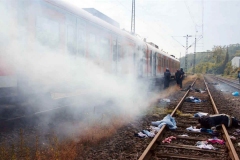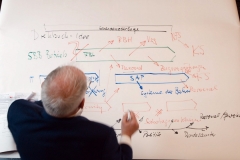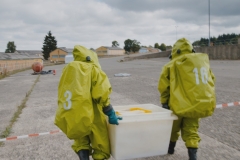Epidemics, crises, attacks: Small and large-scale disasters are played out almost weekly in Germany. They range from local fire drills to large-scale scenarios with hundreds of participants.
MASTER OF DISASTER enters a hidden parallel universe of our everyday life: the world of disaster protectors and researchers who want to foresee the dangers threatening our complex world and train themselves to deal with them.
The film shows the various protagonists in their simulations, test runs, researching human behavior in preparation for a disaster. They work in the secured laboratories for infection research, in federal offices, on training grounds and in the glass palaces of insurance companies. They envision potential disasters in every detail, no matter how small, hoping to be prepared for any loss of control.
It also shows the dedication of the rescue forces, on whose largely voluntary commitment, the entire disaster and accident relief in Germany is based.
Exciting insights are revealed, unexpected connections become visible. Thus the film also raises the question of the controllability of our seemingly controlled world and its problems. A film between facade and reality.
CREW
Regie, Buch: Jürgen Brügger, Jörg Haaßengier
Kamera: Sven O. Hill, Philipp Künzli
Schnitt: Anette Brütsch
Musik, Sounddesign: Daniel Almada
Mischung: Dominik Awenvedde
Bildbearbeitung: Jochen Hinrichs-Stöldt
Produktion: Thomas Tielsch
Koproduzent: Vadim Jendreyko
Produktionsleitung: Jan-Peter Heusermann
Verleih: Filmtank Audience
Presse: Thomas Tielsch
Filmwebseite: www.masterofdisaster-film.de
Gefördert von Filmförderung Hamburg-Schleswig-Holstein, Filmstiftung NRW, BKM
Jürgen Brügger studied theater, film and television studies, history, and sociology at the University of Cologne, followed by postgraduate studies at the Academy of Media Arts Cologne. Jörg Haaßengier studied philosophy and modern German literature in Hanover and Berlin. He also completed postgraduate studies at the Academy of Media Arts Cologne. The two men have been working together Since their joint diploma with Kopfende Haßloch in 2005. As well as their film work, they create new online documentary narrative forms.
In each of their feature films, the two filmmakers investigate those spheres of everyday life that tend to be overlooked, despite their proximity: inconspicuous scenes, often populated by all the more unusual protagonists. The film Exit Eden showcases complex milieus and lives in the seemingly uninhabited no-man’s-lands between railroad tracks, quarry ponds and highways on the outskirts of Cologne. From Ordering Things reports on people who, professionally or privately, try to defy the chaos of the world with cunning systems of order. With Master of Disaster, the filmmakers now pull aside the curtain between us and the parallel universe of those who know how precarious the nets are that hold our everyday lives together, and who reckon with their tearing apart, day after day.
Filmography (selection)
2019
Master of Disaster (Filmtank + Mira Film in co-production with ZDF/3sat and SRF, distribution: Filmtank Audience)
Duisburg Ruhrort: 16 years old without a chance? Documentary, 30 min (WDR)
Stadt aus Schrott, by Jürgen Brügger, Jörg Haaßengier and Gerhard Schick, VR documentary (in preparation) Wim Wenders Fellowship.
2018
Kriegskinder, WDR AR 1933-1945, by Jürgen Brügger, Jörg Haaßengier and Gerhard Schick, augmented reality (WDR), re:publica 2018, nomination CIVIS Media Award 2019
Berlin Terror – Die ersten Helfer vom Breitscheidplatz, by Jürgen Brügger, Jörg Haaßengier and Astrid Schult, Virtual Documentary (WDR), re:publica 2018, Sheffield Int. Documentary Film Festival, nomination Webvideopreis 2018; Best VR Documentary Los Angeles Fine Arts Festival
2017
Inside Auschwitz, by Jürgen Brügger, Jörg Haaßengier and Gerhard Schick, Virtual Documentary (WDR), re:publica 2017, Webvideopreis 2017, Nomination Grimme Online Award 2017.
2016
#nordstadtkinder, by Jürgen Brügger, Jörg Haaßengier and Rainer Nigrelli, web documentary (WDR), German Social Award 2017
Nordstadtkinder: Lutwi, by Jürgen Brügger and Jörg Haaßengier, documentary, 30 min (WDR), Grimme Award 2017
2015
#wowillstduhin, by Jürgen Brügger, Jörg Haaßengier and Rainer Nigrelli, web documentary (WDR)
In times when one disaster report follows another, when people are afraid of new kinds of spreading through our globalized world, when hurricanes and floods challenge our fragile infrastructure, a disaster film of a special kind comes to the cinema: The documentary, Master of Disaster, by Jürgen Brügger and Jörg Haaßengier describes the work of those people and institutions that are supposed to help us when these disasters actually occur. Specialists develop lifelike scenarios, and fire departments, emergency doctors and paramedics, evacuation teams, as well as crisis managers, police, and the German armed forces train for emergencies in large-scale staff exercises. An exciting look behind the scenes of our functioning everyday life.
After watching this film, you perceive your surroundings with different eyes and ask yourself: Should I really bunker down, and stock up on food and water? If everything comes to a standstill, can the volunteer fire department actually help me? Will everything work out all right?
Thematic background
Modern societies and their infrastructures are networked to an unprecedented extent, right into people’s private lives, and are thus not only easy targets for hostile attacks, but are also themselves highly susceptible to a dynamic in which simple disruptions can suddenly give rise to catastrophic emergencies that challenge an entire continent. At the same time, in the globalized, mobile world, there is a growing risk of pandemics some of which are completely unexplored, migrating with travelers from remote corners of the earth to metropolitan areas. And last but not least, the coming climate catastrophe is already casting its shadow in the form of storms, floods and droughts.
Such disasters, both large and small, play out almost weekly in Germany. They range from firefighting drills to large-scale cross-border exercises with several thousand participants and scenarios covering thousands of pages. Gigantic computer simulations calculate incident probabilities, but also the behavior of crowds in panic. Huge databases store the parameters of all the disasters of the last decades worldwide in order to minimize the risks to insurance companies.
Master of Disaster moves thematically between the concrete work of the disaster control experts, a field that affects everybody yet is hardly present in everyday life, and the social questions that arise: can we still control our extremely networked structures? Don’t the gigantic control mechanisms in the machine rooms of our everyday life only lead to further systemic risk?
Disaster researchers agree that our existence is only threatened by a singular event in extremely exceptional cases (e.g. a comet impact or an earthquake). Rather, vulnerability is growing precisely because of less obvious, insidious risks and the concatenation of crisis-related events. These include increasing and widespread dependence on large-scale infrastructures such as electricity supply and also the spread of pandemics, which are facilitated by climate change and the high mobility of people and goods. Through domino effects, natural, technical, social, and economic factors interact to lead to very different and unforeseeable disasters. Such is the consensus among security experts.
By networking and globalizing our infrastructure and production methods to an extent previously unimagined, and by equipping them with artificial intelligence, we run the risk that even a minor disruption will have catastrophic flow on effects. The disaster control experts then speak of cascades. So today we are confronted with man-made natural disasters, and even “real nature”, which rears its head in climate disasters, that can result in such an overarching catastrophes such as the tsunami in Fukushima.
And it is not unlikely, for example, that a very severe winter storm could also occur during an influenza pandemic. (Because both often occur in the second half of winter.) And what happens if a few highly specialized employees of a modern power plant catch the same virus? Then, depending on how the electrical grid is affected, numerous large power plants could shut down. The result would be power failures throughout the European grid or, in the worst case, a Europe-wide blackout. Accordingly, in November 2014, Switzerland, for example, rehearsed a “power shortage situation” caused by the European power grid in one of the largest exercises in recent decades, which was overlaid with a pandemic.
According to experts, the coming of a nationwide power blackout is considered all but certain.
The 2012 Swiss Risk Report expects a total blackout every 50 years.
However, according to disaster researchers, the greatest risk to people, the environment and society comes from pandemics.
The 1918 flu epidemic claimed the lives of some 50 million people. A new type of flu, whether it comes from a wild duck in Guangdong or a seabird from Queensland, could again put millions at risk. That’s because in our globalized world, new infections travel faster and farther than ever before.
For these reasons, the current situation with respect to the Corona virus, which has the potential to become a pandemic, is already more dramatic than the SARS epidemic of 2002/2003.
The SARS agent arrived in Hong Kong by bus in the body of a sick, coughing man from southern China. It hung in the air of the hotel corridor and from there entered the bodies of new victims. With these, he traveled to Beijing, Singapore, Hanoi and Toronto within hours. In Canada alone, the economic damage caused by SARS has been calculated at just under $1 billion, although there were only 251 patients in total, 42 of whom died. Extrapolating this figure to a pandemic involving several million people, as would have been likely if the SARS virus had mutated, results in orders of magnitude of economic damage that would bring any national economy to its knees.
PRESSE
Presskit Download [PDF]
PROTAGONISTS AND LOCATIONS OF THE FILM
Prof. Volker Schmidtchen and Dr. Hans-Walter Borries
Dr. Borries is the managing director of an independent and private institute for economic and security studies founded in 2002 in Witten, North Rhine-Westphalia. Prof. Schmidtchen used to be the director of the institute together with Dr. Borries. Today he is one of the lecturers there. Both are reserve colonels. In the area of security, the focus is on civil protection and disaster relief as well as corresponding crisis management. Here, the institute produces studies and expert reports on relevant security topics, carries out training and further education measures, organizes specialist conferences and participates in research projects. Scenarios for disaster exercises are also developed.
The institute advises and trains authorities, municipalities, organizations, and companies, with security tasks.
Beda Sartory
Beda Sartory is the managing director of an independent and neutral Swiss consulting company in the field of crisis management, crisis communication, risk management, threat management and in the development of security concepts of all kinds. The consultants support companies, decision-makers and executives in the event of a crisis. They look for concrete solutions and sustainable strategies on the spot, and help to contain or prevent damage. In terms of prevention, they set up the respective company’s internal crisis organization, train crisis teams and check the level of training with a crisis team exercise tailored to the company, and aligned to real crisis scenarios. The film shows a large crisis team exercise of the Swiss Federal Railways, whose scenario was developed and implemented by Sartory’s company. Daniel Schlup is head of the emergency and crisis management department of the SBB, his department was trained in this exercise.
Prof. Dirk Helbing
Dirk Helbing is a German physicist and sociologist, Professor of Computational Social Science at ETH Zurich since 2007. He also works as a researcher at the University of Tel Aviv, the Weizmann Institute in Israel, Eötvös University in Budapest, and Xerox PARC in California. He has worked with various complex systems – from the self-organization of pedestrians, to mass panics and traffic jams, from bacterial patterns to la-ola waves. He has worked on ways to reduce the causes and consequences of mass panics and thus more effectively contain disasters.
Prof. Dr. Martin Voss
Voss works as the head of the Disaster Research Unit KFS at the Institute for Social and Cultural Anthropology at the FU Berlin. The focus of the disaster research center is on cultural and social aspects. According to the KFS’s self-conception, disasters must be understood in their cultural and social contexts. Extreme weather events, for example, only become risks when they coincide with social and cultural institutions and behaviors. The goal is to use the research results to develop evacuation plans that can be used to control large-scale displacements.
“Crowd management” is the name of the process through which large-scale displacements are controlled. Martin Voss: “We want to be able to calculate within a minute what will happen within the next quarter of an hour. Because when an escape or evacuation goes wrong, it’s often not a result of recklessness, but simply physical inevitability.” The Disaster Research Center is also working on an app that will call in empowered laypeople (e.g., janitors) to help quickly during disaster situations. The exercise shown in the film tested the behavior of people from different backgrounds in the event of a disaster. The location of the exercise was Fighting City in Berlin, a training area built by the British to train in house-to-house combat. The site included numerous residential buildings with up to five floors, a gas station, a supermarket, an underground parking garage, a sewer system, several ramparts and trenches, two bridges and a road network. After the withdrawal of the Allies, Fighting City was handed over to the Berlin police in 1994.
Dr. Leon Hempel
Dr. Leon Hempel studied Comparative Literature and Political Science at the Technical University of Berlin and has been a research associate at the Center for Technology and Society since 1999. Over the past ten years, he has continuously built up social science security research and established it as a discipline in its own right. Hempel has coordinated and lead national, European and international projects in the field of security since 2000.
The film shows behavioral observation in control centers, conducted as part of the AlphaKomm research project that deals with communication problems in the event of a crisis. Since in highly networked infrastructures small problems in one area have big flow on effects, the quality of communication between authorities, organizations and companies is of central importance. AlphaKomm was conducted in cooperation with the Berlin Fire Department.
Prof. Dr. Lars Schaade
Head of Department at the “Center for Biological Hazards and Special Pathogens (ZBS)” at the Robert Koch Institute, Berlin. The Robert Koch Institute is the central institution of the Federal Government in the field of disease surveillance and prevention and thus also the central institution of the Federal Government in the field of biomedical research. The Institute’s core tasks are the detection, prevention and control of diseases, especially infectious diseases. It aims to analyze highly infectious agents in disease outbreaks or terrorist attacks and to develop plans to prevent or combat infections or poisonings.
In the high-security laboratories, viruses and bacteria, such as anthrax, plague and cholera, are studied. The crisis management of health authorities is supported and advised, as in the current case of the Corona virus, and early warning systems are developed. With regard to the recognition of health hazards and risks, the RKI thus performs a central “antenna function” in the sense of providing an early warning system. In the film, Prof. Dr. Schaade gives a tour of the Center for Biological Hazards and Special Pathogens. The film also shows scenes from an Interpol exercise in Berlin: teams from all over Europe practice securing evidence in the event of an attack with biological weapons as part of a workshop.
Academy for Crisis Management, Emergency Planning and Civil Defense (AKNZ) at the Federal Office for Civil Protection, Bad Neuenahr-Ahrweiler.
The Academy is the central training, and advanced training, center for the Federal Government in all areas of disaster management and security preparedness. In large-scale staff exercises, state institutions and authorities, such as the police, the Bundeswehr, and intelligence services, are trained here together with the security officers at power utilities, etc. Every two years, the two-day national disaster exercise LÜKEX I held, always with a different scenario and at a different location, controlled from Ahrweiler. Interdepartmental seminars are also held here to prepare the various crisis managers for all possible threat scenarios. The film shows the development of a scenario involving a terrorist attack on a train station.
Simulation Center Essen
The simulation center in Essen conducts training for the personnel of all German nuclear power plants and one Dutch nuclear power plant. Here, control rooms of German nuclear power plants are reproduced in detail.
The training in technical aspects is supplemented by extensive behavioral training.
Weeze Training Site
The site is run by a private operator who organises training exercises for the police, fire department, military and the like. There are more than 100 realistic training objects on an area of more than 50 hectares. Rescue services and disaster control personnel conduct training in collapsed buildings and damage scenarios. In the film a large-scale exercise day of the Duisburg fire department is shown.
Swiss Fort Knox
Swiss Fort Knox is an underground, highly secure data center in the Swiss Alps, a converted military installation with its own airfield. All facilities have self-sufficient utilities in all areas and a climate independent of the outside world. The building structure is resistant to any military or civilian threat. Vandalism, elemental & environmental damage, IT access problems (quarantine), terror / sabotage. In the film Christoph Oschwald provides a guided tour of the facility.
Swiss RE
Swiss Reinsurance Company (Swiss RE for short), headquartered in Zurich, is the world’s second largest reinsurance company after Munich RE. Reinsurers / insurers operate in a rapidly changing and increasingly complex risk landscape. This results in “emerging risks” – emerging or changing risks that are difficult to quantify. Risk specialists regularly collect and evaluate these risk terms for their potential impact on the business.






